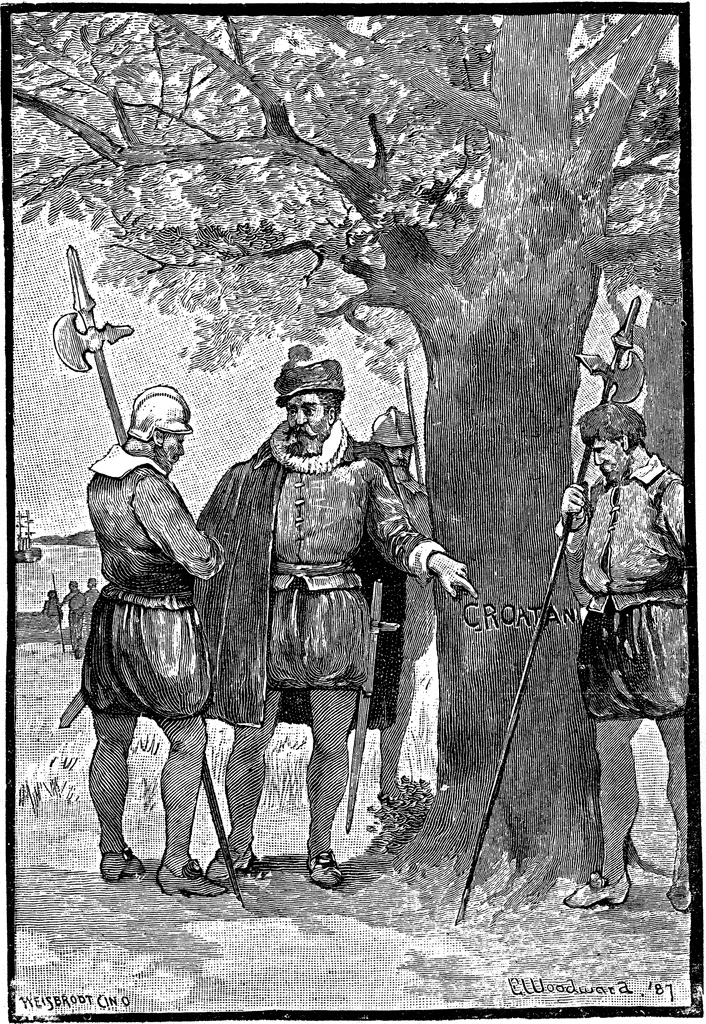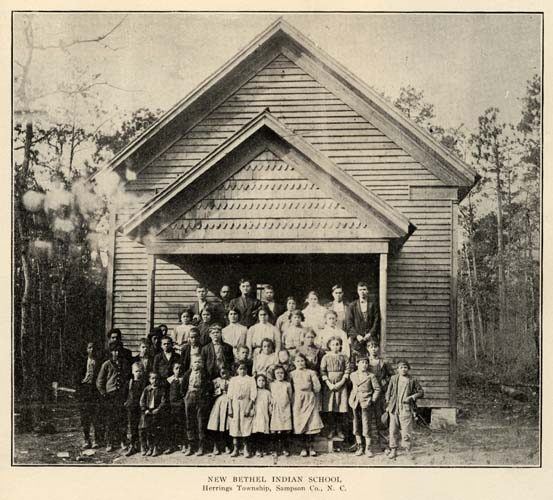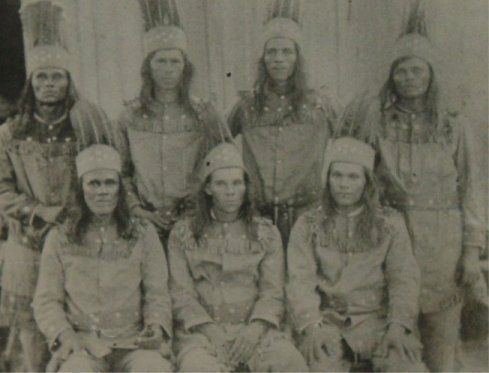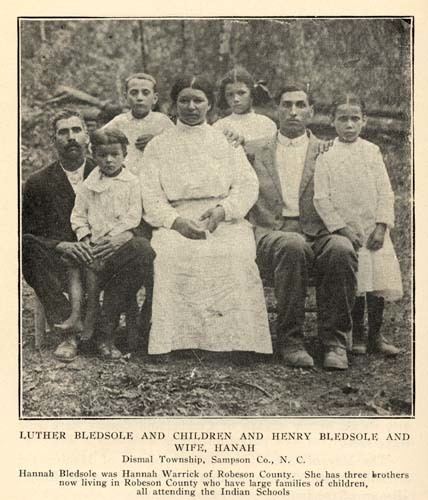 | ||
The Croatan (also spelled Croatoan) were a small Native American group living in the coastal areas of what is now North Carolina. They may have been a branch of the larger Roanoke people or allied with them.
Contents
- History
- Beliefs
- European colonization
- The Lost Colony
- Speculation of the fate of the Lost Colony
- Modern era and legacy
- References

History

The Croatan lived in current Dare County, an area encompassing the Alligator River, Croatan Sound, Roanoke Island, and parts of the Outer Banks, including Hatteras Island. Now extinct as a tribe, they were one of the Carolina Algonquian peoples, numerous at the time of English encounter in the 16th century. The Roanoke territory also extended to the mainland, where they had their chief town on the western shore of Croatan Sound. Scholars believe the Algonquians had a total population of 5,000 to 10,000.

Croatan Indians were a part of the Carolina Algonquians, a southeastern designation of the greater Algonquian source. Agriculture was the Native Americans' primary food source, and the fact that they could feed the colonists as well as themselves demonstrates very effectively the efficiency of their farming. The Native Americans regulated each person’s position in society by public marks. The chiefs or leaders, called werowances, controlled between one and eighteen towns. The greatest were able to muster seven or eight hundred fighting men. The English marveled at the great awe in which these werowances were held, saying no people in the world carried more respect towards their leaders. Werowance actually means “he who is rich”. Chiefs and their families were held in great status and with respect, but they had to convince followers that action or cause was wise, they did not command. The role of the chief was to spread wealth to his tribe, otherwise respect was lost.
Beliefs

The Native Americans living in the Carolinas believed in the immortality of the soul. Upon death, the soul either enters heaven to live with the gods or goes to a place near the setting sun called Popogusso, to burn for eternity in a huge pit. The concept of heaven and hell was used on the common people to respect leaders and live a life that would be beneficial to them in the afterlife. Conjurors and Priests were distinctive spiritual leaders. Priests were chosen for their knowledge and wisdom, and were leaders of the organized religion. Conjurors on the other hand were chosen for their magical abilities. Conjurors were thought to have powers from a personal connection with a supernatural being (mostly spirits from the animal world).
European colonization

It is known that the coming of Europeans upset tribal relationships; some tribes, such as the Algonquian people, advocated cooperation while others, such as the Yamasee, Cherokee, and Chickasaw, resisted. The conflict between certain tribes and the English settlers later led to the Yamasee War. Those tribes that did maintain contact with the settlers gained power through their access to and control of European trade goods. While the English may have held great military might over the Carolina Algonquians, the Native Americans' control over food and natural resources was a much more decisive factor in the conflict with early settlers. Despite the varying relationships among tribes, the Roanoke and Croatan were believed to have been on very good terms with English settlers of the Roanoke Colony. Wanchese, the last leader of the Roanoke, accompanied the English on a trip to England.
The Lost Colony
It is possible that some of the survivors of the Lost Colony of Roanoke may have joined the Croatan. Governor White finally reached Roanoke Island on August 18, 1590, three years after he had last seen them in Virginia, but he found his colony had been long deserted. The buildings had collapsed and "the houses [were] taken down". The few clues about the colonists’ whereabouts included the letters "CROATOAN" carved into a tree. Croatoan was the name of a nearby island (likely modern-day Hatteras Island) and a local tribe of Native Americans. Roanoke Island was not originally the planned location for the colony and the idea of moving elsewhere had been discussed. Before the Governor's departure, he and the colonists had agreed that a message would be carved into a tree if they had moved and would include an image of a Maltese Cross if the decision was made by force. White found no such cross and was hopeful that his family was still alive.
The Croatan, like other Carolina Algonquians, suffered from epidemics of infectious disease, such as smallpox in 1598. These greatly reduced the tribe's numbers and left them subject to colonial pressure. They are believed to have become extinct as a tribe by the early seventeenth century.
Speculation of the fate of the "Lost Colony"
Based on legend, some people said that the Lumbee tribe, based in North Carolina, were descendants of the Croatan and survivors of the Lost Colony of Roanoke Island. For over a hundred years, historians and other scholars have been examining the question of Lumbee origin. Although there have been many explanations and conjectures, two theories persist. In 1885, Hamilton McMillan, a local historian and state legislator, proposed the “Lost Colony” theory. Based upon oral tradition among the Lumbees and what he deemed as strong circumstantial evidence, McMillan posited a connection between the Lumbees and the early English colonists who settled on Roanoke Island in 1587 and the Algonquian tribes (Croatan included) who inhabited coastal North Carolina at the same time. According to historical accounts, the colonists mysteriously disappeared soon after they settled, leaving little evidence of their destination or fate. McMillan's hypothesis, which was also supported by the historian Stephen Weeks, contends that the colonists migrated with the Indians toward the interior of North Carolina, and by 1650 had settled along the banks of the Lumber. It is suggested the present-day Lumbees are the descendants of these two groups.
Other scholars believe the Lumbees to be descended from an eastern Siouan group called the Cheraws. During the seventeenth and eighteenth centuries a number of Siouan-speaking tribes occupied southeastern North Carolina. John R. Swanton, a pioneering ethnologist at the Smithsonian Institution, wrote in 1938 that the Lumbees were probably of Cheraw descent but were also genealogically influenced by other Siouan tribes in the area. Contemporary historians such as James Merrell and William Sturtevant confirm this theory by suggesting that the Cheraws, along with survivors of other tribes whose populations had been devastated by warfare and disease, found refuge from both aggressive settlers and hostile tribes in the Robeson County swamps in eastern North Carolina.
Late twentieth-century research has demonstrated that among surnames established as Lumbee ancestors were numerous mixed-race African Americans free in Virginia before the American Revolution, and their descendants who migrated to the Virginia and North Carolina frontiers in the late eighteenth and early nineteenth centuries. These "free people of color" were mostly descendants of European women and African men, who worked and lived together in colonial Virginia. These connections have been traced for numerous individuals and families through court records, land deeds and other existing historical documents. In Robeson County, they may have intermarried with Native American survivors and acculturated as Indian.
Modern era and legacy
The Lost Colony Center for Science and Research has excavated English artifacts within the territory of the former Croatan tribe. The artifacts may also be evidence of trade with the tribe, or of Indians' finding them at the former colony site. The Center is conducting a DNA study to try to determine if there are European lines among Croatan descendants.
A historical marker placed by the state of Georgia states "In 1870 a group of Croatan Indians migrated from their homes in Robeson County North Carolina, following the turpentine industry to southeast Georgia. Eventually many of the Croatans became tenant farmers for the Adabelle Trading Company, growing cotton and tobacco. The Croatan community established the Mt. Zion Baptist Church in Adabelle, as well as a school and a nearby cemetery. After the collapse of the Adabelle Trading Company, the Croatans faced both economic hardship and social injustice. As a result, most members of the community returned to North Carolina by 1920."
Researchers from the University of Bristol, UK have also been excavating on Hatteras Island in conjunction with the Croatoan Archaeological Society. Hateras Island is the main locus for the settlement of the Croatoan tribe, and to date they have discovered a large contact/pre-contact period settlement, midden deposits and fascinating European trade items.
